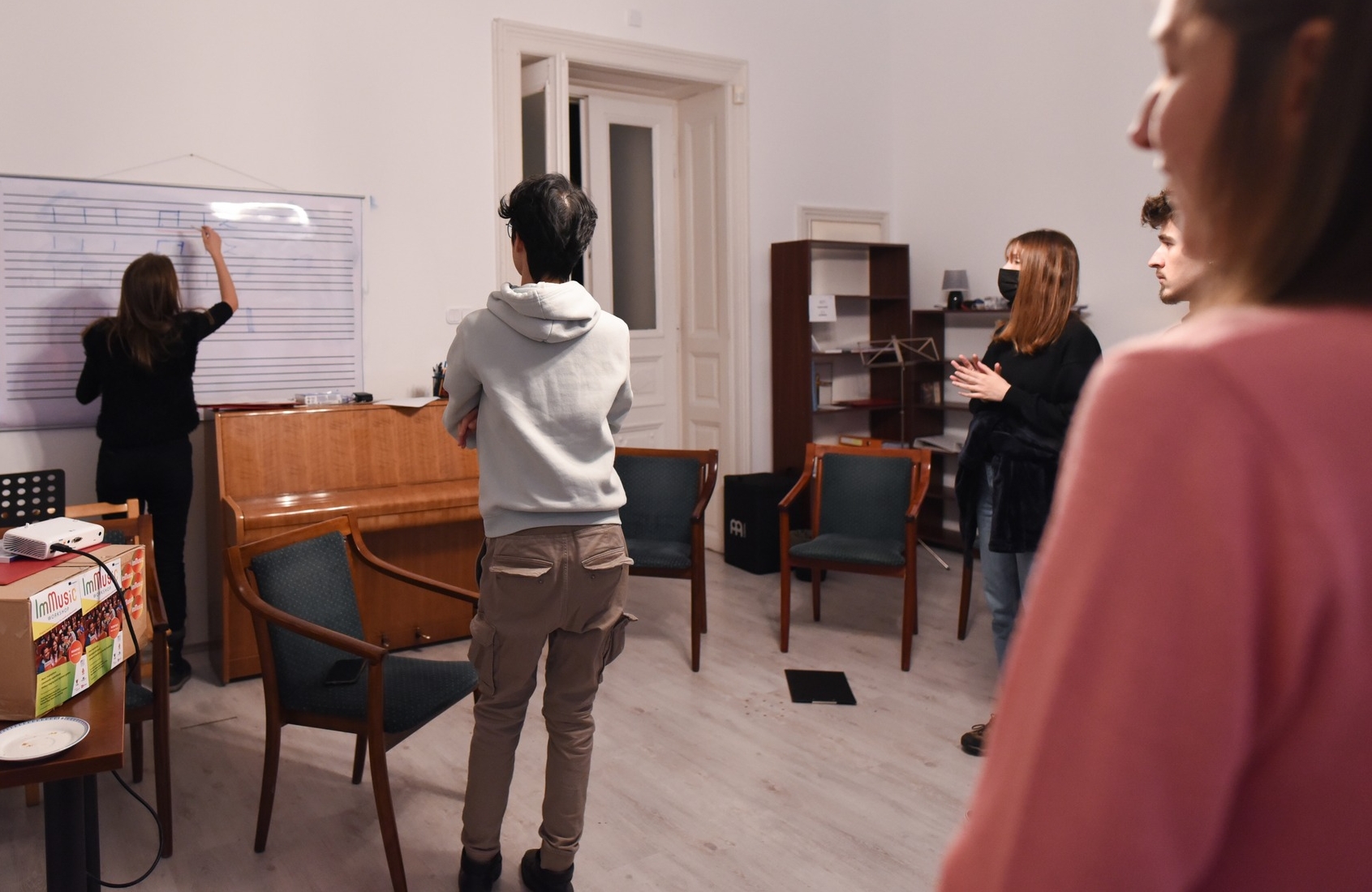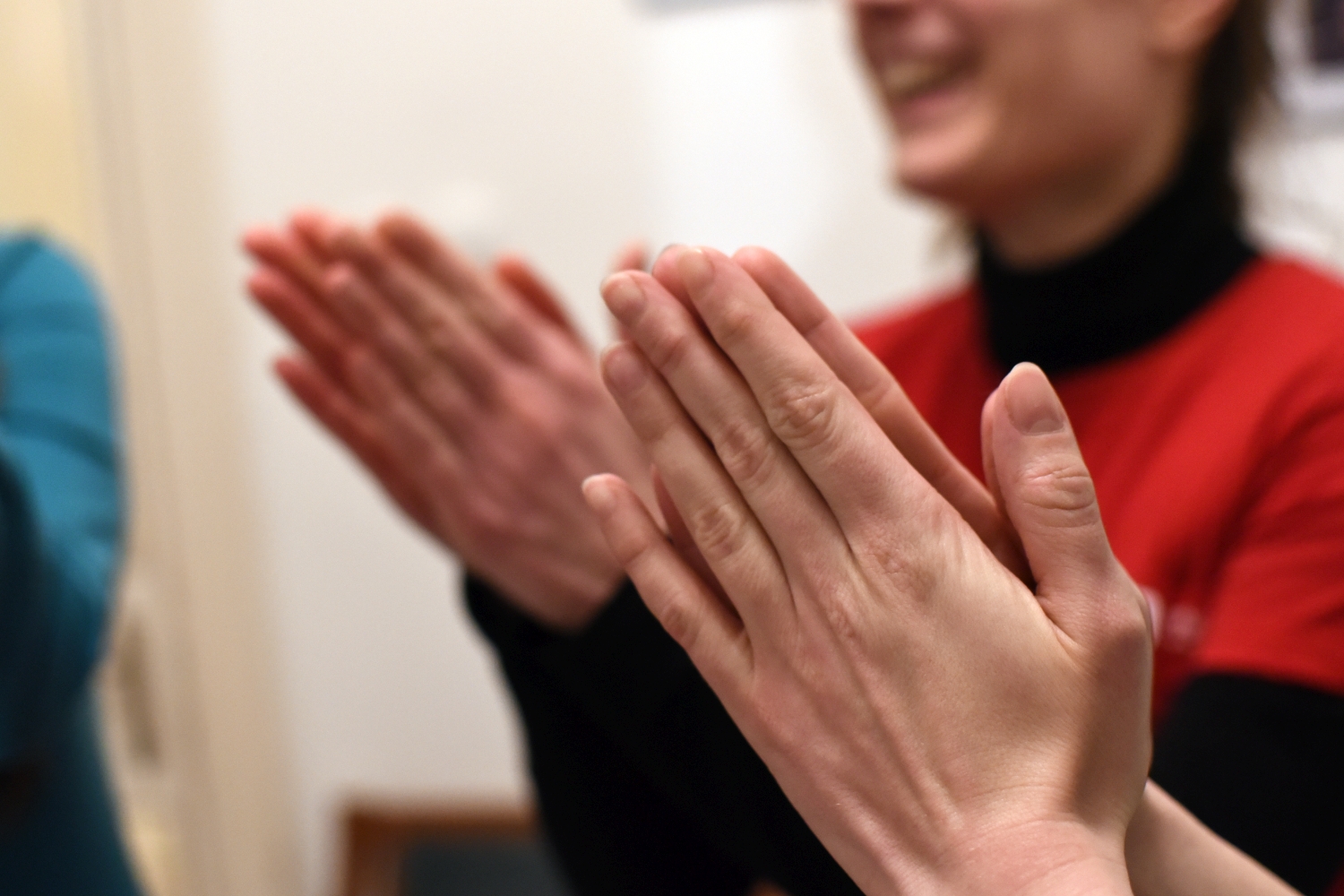by immusic | Nov 30, 2022
Category
rhythmic
Age
8+
Number of participants
10-30
Duration
approx. 10 min.
Working method
group work
Musical abilities of the trainers
1 2 34 5 6
Equipment and instruments
- paper, pen
- optional – any drums and rhythm instrument
Competences
- creativity
- collaboration
- attention
- concentration
- rhythm recognition
Rhythm Map
In this game sheets with special characters (any character
that are not on a classic sheet) have to be created
and performed by the team.
AIM
This is a game for improving cooperation skills and developing focus in a creative way. Creating the sheet and coming up with rhythms is a great team building exercise. By living in the rhythm create a fun atmosphere.
Description
The facilitator creates two groups and explains the task.
First group has to find out a specific rhythm pattern that the other group needs to play on their bodies or rhythm instruments. This part of the game is like a music sheet creation task: they have to capture the rhythm, however they cannot use classic notes but symbols.
For example:
instead of „ ♪ ♫ ” they can use symbol “$” and they have to explain it means: beat with your feet
or with the symbol „❤” they want the other group to clap their hands etc.
When the first group finishes, the second group performs it based on the instructions – as a music reading task.
by immusic | Nov 30, 2022
Category
vocal
Age
8+
Number of participants
8-25
Duration
approx. 15 min.
Working method
group work
Musical abilities of the trainers
1 2 3 4 5 6
Competences
- creativity
- collaboration
- attention
- concentration
- musical hearing
- rhythm recognition
Composition Game
In this game sheets with special characters – any character
that are not on a classic sheet – have to be created
and performed by the team.
AIM
This is a game for improving cooperation skills and developing focus in a creative way. Creating the sheet and coming up with a song with rhythms is a great team building exercise. By listening to the song to be performed, it adds to the fun atmosphere.
Description
The facilitator creates two groups and explains the task.
First group has to find a simple song that the other group needs to play on a music device or by heart. This part of the game is like a music sheet creation task: they have to capture the song, however they cannot use classic notes but symbols.
For example:
instead of „ ♪ ♫ ” they can use symbol “$” and they have to explain it means: sing „LA”
or with the symbol „❤” they want the other group to sing another note
etc
When the first group finishes, the second group performs it based on the instructions – as a music reading task.
by immusic | Nov 29, 2022
Category
vocal
Age
12-25
Number of participants
8-12
Duration
approx. 35 min.
Working method
Musical abilities of the trainers
1 2 3 4 5 6
Equipment
and instruments
- music player / app
to play the song
Competences
- learning and memory skill
- collaboration
- attention
- concentration
- creativity
- sense of rhythm
Charlie over the Ocean
The music game inspired by the aquatic life is suitable
and easy for those participants who are inexperienced
in music or for musicians at all levels.
AIM
The main objectives of these music activities are to introduce participants to the joy of playing and singing songs together, as well to provide some knowledge of musical experience, understanding and enjoyment.
Description
Before starting the game, the facilitator asks the young people to think of something that is in the ocean, seas. Let them use their imagination, what they want to see more closely, get to know.
The participants sing or learn the song several times so that they no longer have to concentrate on the sounds and the text during the game. When the word {blackbird} is reached in the third line of the text, everyone must replace it with the word they thought of at the beginning of the game, but it is important to keep the rhythm (e.g. speed up the syllables).
- Participants are standing in a circle, hands are clasped, and the instructor is on the outside.
- With a steady beat he/she begins walking around the outside of the circle singing the solo, echoed by the group. Don’t forget to use the words that everyone has come up with!
- On the last word, he/she taps the participant closest to him/her. Racing around the circle, if the chosen player tags the first participant before they reach the opening in the circle they win their place back and the song is sung again. If not, they become the new soloist.
Lyrics
Solo:
Charlie over the ocean,
Charlie over the sea,
Charlie caught a {blackbird}
Can’t catch me.
Group:
Charlie over the ocean, (echo)
Charlie over the sea, (echo)
Charlie caught a {blackbird} (echo)
Can’t catch me. (echo)
comments for facilitators
During the activities be care of the steady beat.
There are countless versions of these popular songs, and they have varied in lyrics and melody over the years, so you can learn any version.
by immusic | Nov 29, 2022
Category
vocal
rhythmic
Age
12-25
Number of participants
8-12
Duration
approx. 15 min.
Working method
group work
Musical abilities of the trainers
1 2 3 4 5 6
Equipment and instruments
- optional: percussion instrument
- music player / app to play the song
Competences
- creativity
- collaboration
- attention
- concentration
- movement coordination
- rhythm recognition
- sense of rhythm
Do as I’m Doing
Singing a simple melody with movements
and rhythmic accompaniment.
AIM
The main objectives are to introduce participants to the joy of singing songs together, as well to provide some knowledge of musical experience, understanding and enjoyment. Besides developing their skills with these musical activities, participants can have a great time experiencing a flow state.
Description
It’s a simple follow me game: the participants imitate the leader while singing. Adapting to the text, we follow the instructions in the last line in movement: fast, slow, high and low.
For example: participants stand in a circle and clap in the tempo according to the lyrics. They can repeat the song with marching motions, then go back to clapping to finish song.
After a while, the leader passes the baton (for example to the person next to her/him in the circle), the point is that as many people as possible become leaders in the game.
At the beginning of the game, even learning the sounds is important, it is worth starting with simple movements. But afterwards, the imagination can be unleashed, what kind of movements we can invent while keeping the rhythm.
Lyrics
Do as I’m doing, follow, follow me,
Do as I’m doing follow, follow me.
If I do it high or low, if I do it fast or slow.
Comments for facilitators
During the activities be care of the steady beat.
There are countless versions of these popular songs, and they have varied in lyrics and melody over the years, so you can learn any version.
Percussion instruments can be used during the musical games, e.g. drums, percussion eggs, wood maracas, rhythm sticks, bells or castanets.
by immusic | Nov 29, 2022
Category
rhythmic
Age
12+
Number of participants
8-12
Duration
approx. 30 min.
Working method
Musical abilities of the trainers
1 2 3 4 5 6
Equipment
and instruments
- optional: percussion instrument
Competences
- creativity
- attention
- collaboration
- concentration
- rhythm recognition
- sense of rhythm
- memory
The Poison Rhythm
A rhythmic game that focuses on concentration
and at the same time develops a sense of rhythm
without being noticed.
AIM
The main goal of the activity is to develop participants’ steady beat competency by involving different rhythmic patterns and various body movements.
Description
The activity starts with the instructor clapping a four-beat rhythm that is labelled the ‚poison rhythm’.
He/she will then clap a series of four beat rhythms to the participants, which they repeat.
When the instructor claps the poison rhythm, the participants should remain silent.
If anyone accidentally claps the poison rhythm, he/she is out of the game. This is a simple and enjoyable way to help participants recognize different rhythm patterns.
The role of leader can also be transferred here so that as many people as possible can use their creativity.
Examples of poison rhythm and four-beat rhythmic patterns:
comments for facilitators
Percussion instruments can be used during the rhythmic games, e.g. drums, percussion eggs, wood maracas, rhythm sticks, bells or castanets.
During the activities be care of the steady beat! The dynamics of the activities can be changeable.









Recent Comments